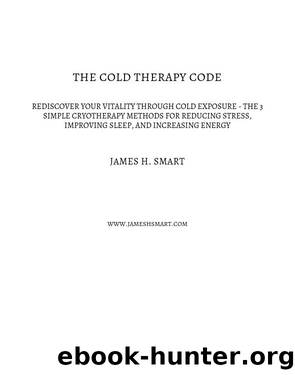The Cold Therapy Code by James H Smart

Author:James H Smart
Language: eng
Format: epub
Publisher: James H Smart
Published: 2022-06-24T00:00:00+00:00
Human response to stress curve (*according to Nixon P: Practitioner 1979, Yerkes RM, Dodson JD). 1
The type of stress that we should do our best to avoid is chronic stress. Whereas acute stress can raise us to new heights, chronic stress can have many negative effects on your emotional and physical health. It can manifest in feelings of overwhelm, irritability, fatigue, and even depression.
Your perception is a very important tool in your arsenal when protecting against stress. The exact same situation can be perceived by two people in completely different ways. If you feel that a stressful situation is something that you can overcome, then the stress you experience will be reduced. If you feel that the situation is outside of your capacity, then the feelings of stress are likely to be higher. Another important note here is remembering to âcontrol the controllable.â Itâs futile to stress over something that is outside of your control.
Stanford Psychologist Kelly McGonigal, in her 2013 TED talk âHow to make stress your friend,â2 claims that it is not stress that kills you; itâs the story you tell yourself about stress.
McGonigal administered a socially evaluated stress test to teach participants how to improve their stress response. She concluded that participants who were told that their stress responses were helpful experienced an elevated heart rate, which is a typical stress response. However, they didnât experience the usual constriction of blood vesselsâthe thing that makes stress bad for our hearts. We may not be able to rid our lives of stress, but we can learn to interpret it differently so that itâs not as harmful.
Cold exposure is a way of intentionally inducing stress, but in a controlled manner. When stress is mild and controllable, it can lead to positive outcomes later in life. The reason for repeatedly inducing short bouts of physical stress is for the body and brain to adapt to accommodate stress. After making cold exposure a habit, you will be able to control the stress of the cold. Cold exposure teaches us that we can control our stress response. Initially, cold water will induce a cold shock response, which is a gasp reflexârapid breathing that subsides as your body becomes accustomed to the cold temperature. The more often you are exposed to the cold, the more accustomed you will be to the shock response.
One way psychologists evaluate stress response is by using a Socially Evaluated Cold Pressor Test3 (SECPT). The test involves subjects immersing one hand in cold water for three minutes. The test generates a strong response from the sympathetic nervous system. Subjects heart rate and blood pressure increase, stress hormones cortisol and norepinephrine increase. Essentially the body goes into fight or flight mode, which is the bodyâs natural response to danger.
A 2014 study4 showed that the physiological effects of cold stress are reduced over repeated exposures. Heart rate response to SECPT was less during the third exposure compared to the first. Subjectsâ perceptions of the stress and cortisol release were also reduced upon repeat exposure.
Download
This site does not store any files on its server. We only index and link to content provided by other sites. Please contact the content providers to delete copyright contents if any and email us, we'll remove relevant links or contents immediately.
| Acupuncture & Acupressure | Aromatherapy |
| Ayurveda | Chelation |
| Chinese Medicine | Energy Healing |
| Healing | Herbal Remedies |
| Holistic | Homeopathy |
| Hypnotherapy | Massage |
| Meditation | Naturopathy |
| Reference |
Inner Engineering: A Yogi's Guide to Joy by Sadhguru(6752)
The Power of Now: A Guide to Spiritual Enlightenment by Eckhart Tolle(5680)
Fear by Osho(4698)
Ikigai by Héctor García & Francesc Miralles(4173)
The Art of Happiness by The Dalai Lama(4092)
The Ultimate Bodybuilding Cookbook by Kendall Lou Schmidt(3906)
Yoga Therapy by Mark Stephens(3721)
The Little Book of Hygge by Meik Wiking(3660)
The Healing Self by Deepak Chopra(3525)
Why Buddhism is True by Robert Wright(3423)
The Hatha Yoga Pradipika (Translated) by Svatmarama(3282)
Being Aware of Being Aware by Rupert Spira(3247)
Shift into Freedom by Loch Kelly(3167)
Wild Words from Wild Women by Stephens Autumn(3117)
Work Clean by Dan Charnas(3080)
Happiness by Matthieu Ricard(3020)
More Language of Letting Go: 366 New Daily Meditations by Melody Beattie(3003)
Yoga Body & Mind Handbook by Jasmine Tarkeshi(2850)
Why I Am Not a Feminist by Jessa Crispin(2724)
